Key takeaways:
- News hoaxes spread easily, often driven by emotional reactions, which can cloud judgment and lead to misinformation sharing.
- Hoaxes can mobilize communities based on fabricated claims and erode trust in legitimate media sources, causing long-term cynicism toward news.
- Critical thinking and skepticism are essential for navigating misinformation, emphasizing the importance of fact-checking and diverse media consumption.
- Engaging in discussions about misinformation with others can enhance understanding and promote clarity in a complex media landscape.
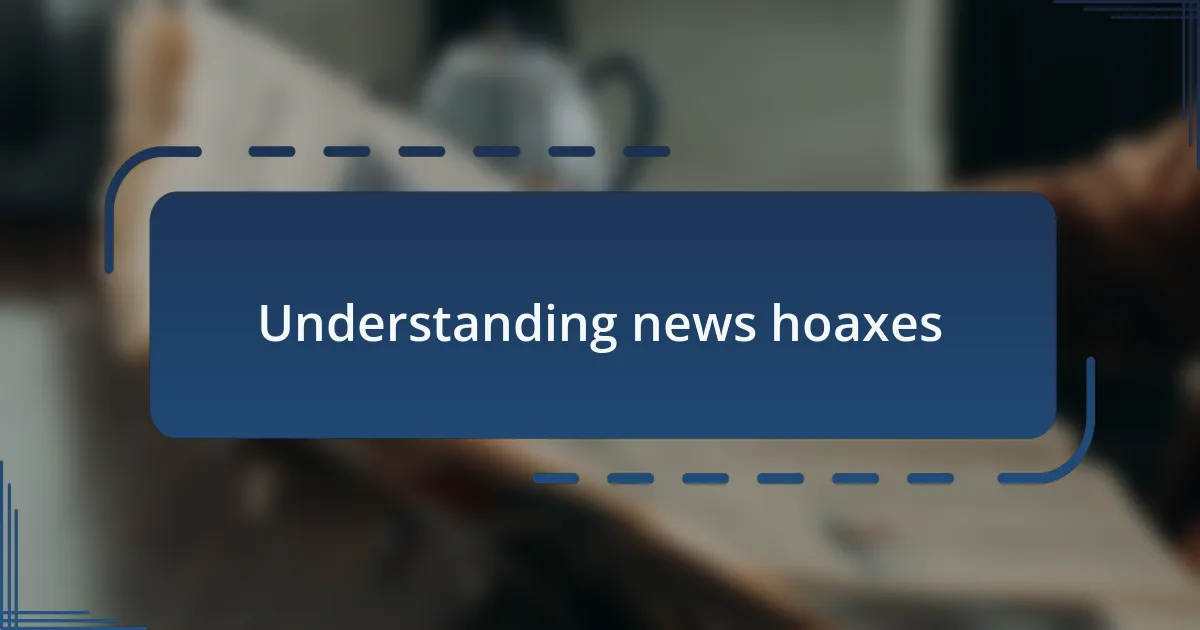
Understanding news hoaxes
As I reflect on my experiences with news hoaxes, I realize how easily misinformation can spread, especially in this digital age. One moment, I was captivated by an outrageous headline, and before I knew it, I was sharing it with my network. Thinking back, I often wonder how many others fell for the same trap; it’s a sobering reminder of our responsibility to verify information before passing it on.
Understanding news hoaxes requires digging deeper into the psychology behind why we share them. I’ve often caught myself sharing sensational stories, and each time, it sparked that thrill of engagement. But what drives that? Is it simply the desire for validation, or is there a deeper yearning for connection in a world flooded with information?
I also find myself pondering the role of our emotions in identifying news hoaxes. For instance, when a story tugs at our heartstrings or ignites anger, we might overlook the need for fact-checking. In one instance, I shared a shocking post about a local event without verifying it first, driven by a strong emotional reaction. This taught me to pause and appraise the source and content more critically, reminding me that our emotional responses can often cloud our judgment.
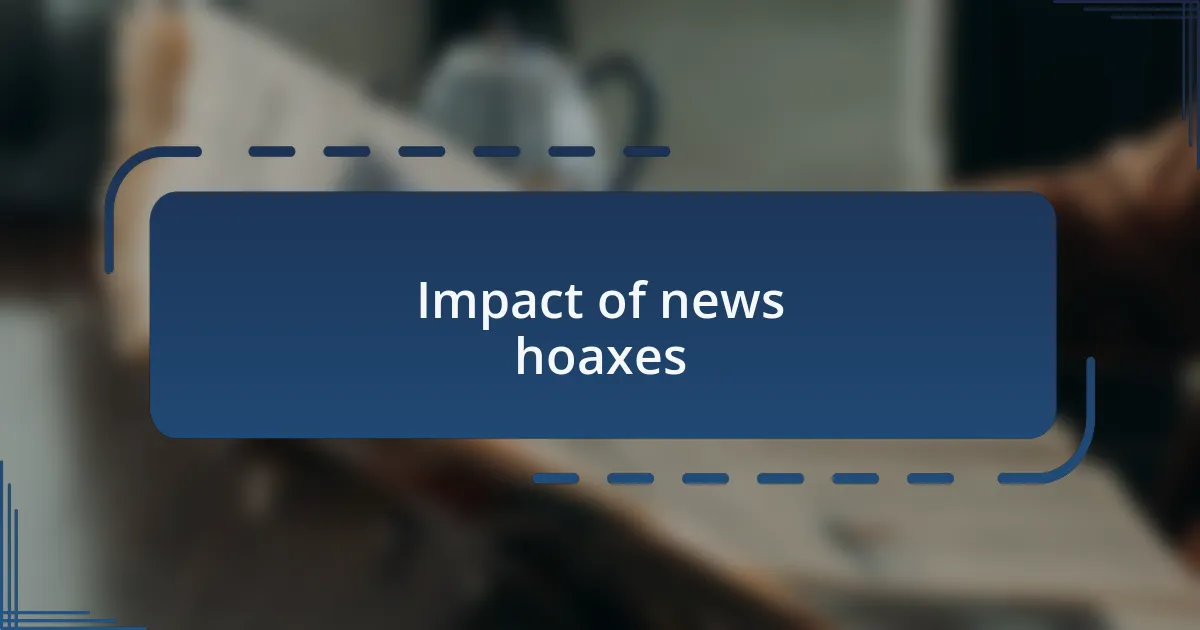
Impact of news hoaxes
The impact of news hoaxes is often profound, influencing public opinion and behavior in unpredictable ways. For instance, I recall a story that circulated about a supposed government policy change. It not only sparked outrage but also led to protests. This taught me that a single misleading article can mobilize entire communities, igniting a fire based on fabricated claims.
Additionally, I’ve experienced firsthand how news hoaxes can erode trust in legitimate media sources. After falling for a particularly outrageous headline, I found myself scrutinizing every article that followed, questioning the credibility of even well-established news outlets. This inner conflict left me wondering: if I, someone keenly interested in accurate information, struggled with doubt, how can we expect the general public to discern fact from fiction?
The psychological toll of news hoaxes can be staggering. When emotions run high and misinformation spreads, the feeling of being deceived can foster apathy or cynicism toward news. I’ve spoken to friends who, disheartened by their experiences with fake news, turned away from media altogether. It’s a stark reminder that the fallout of a hoax extends beyond the moment of deception; it cultivates a long-lasting ripple effect that impacts our collective engagement with news and information.
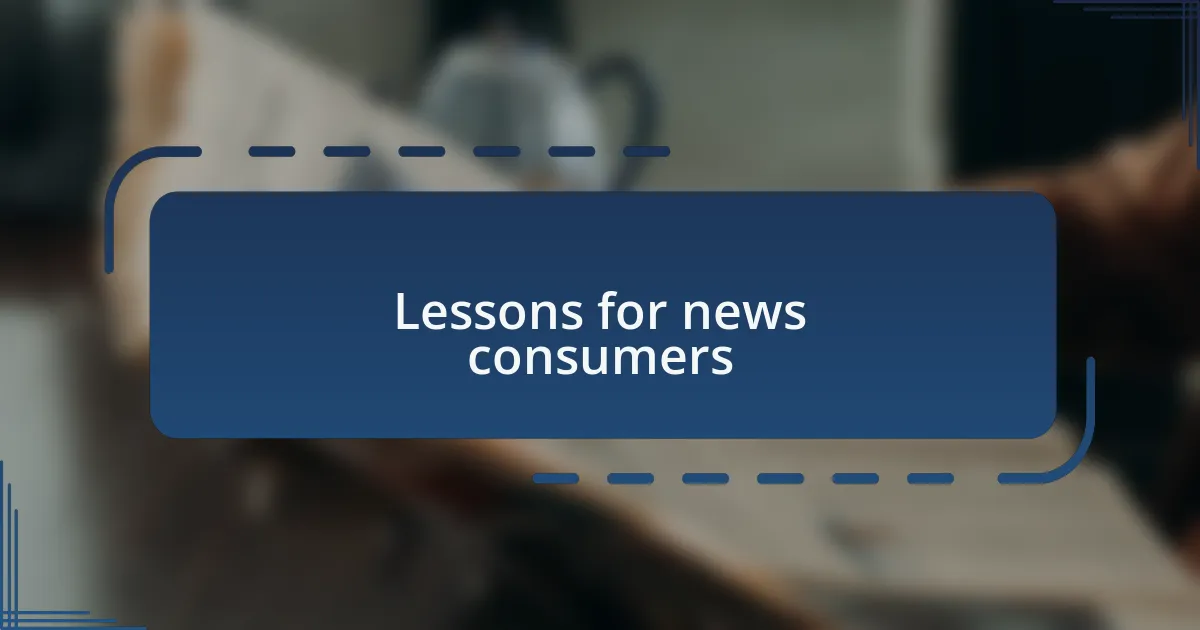
Lessons for news consumers
When it comes to navigating the news landscape, I’ve learned the importance of questioning everything I read. Recently, I stumbled across a sensational article claiming that a vaccine had been linked to an alarming increase in health issues. My initial reaction was panic, but then I paused and sought out reliable sources to verify the claim. This experience reinforced an essential lesson: cultivating a habit of skepticism is crucial. If we take a moment to fact-check, we can often avoid falling prey to misinformation.
Another key lesson I’ve taken to heart is the value of diverse media consumption. I used to rely primarily on one outlet for my news, believing it to be the most trustworthy. However, after discovering that it published a misleading story, I realized just how important it is to expose myself to a variety of perspectives. By exploring different news sources, I not only gain a more balanced understanding but also empower myself to recognize biases and agendas that might not be immediately apparent.
Lastly, I’ve learned that sharing news responsibly is an essential step for all of us. I remember feeling compelled to share an alarming headline on social media without fully digesting the facts. Once I realized it was based on a hoax, I felt a wave of guilt for potentially misleading my friends. This taught me that our role as consumers extends beyond mere consumption; we should be mindful of how we contribute to the spread of information. Are we amplifying facts or fueling fiction? This responsibility weighs on us more than we might realize.
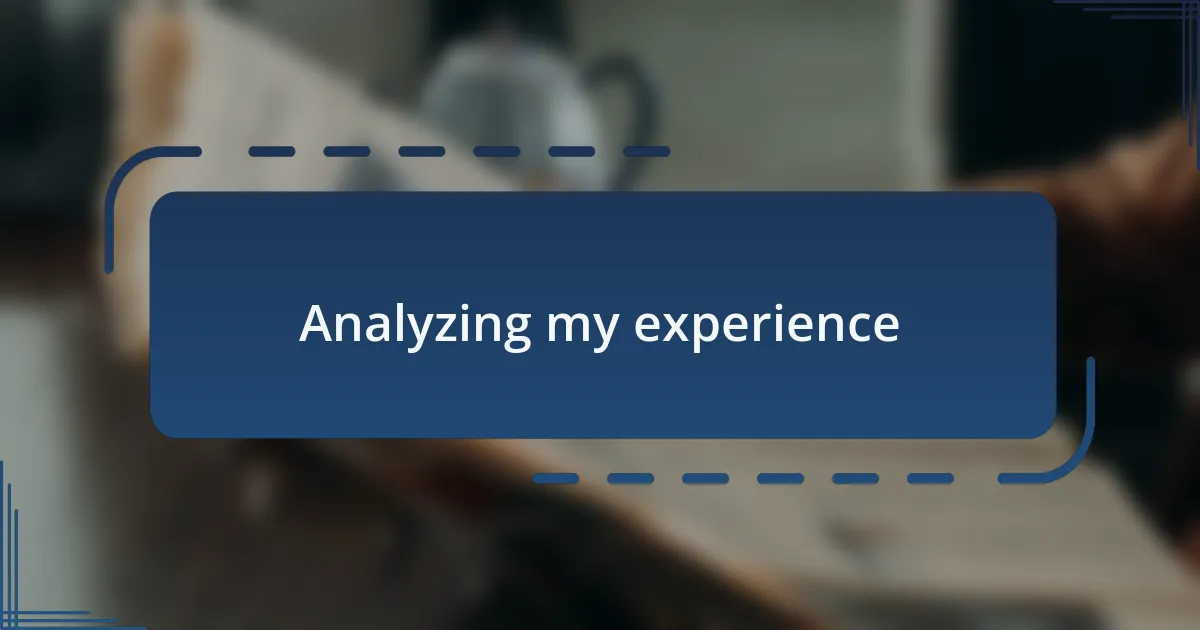
Analyzing my experience
Reflecting on my experience with the news hoax, I realize how quickly emotions can cloud judgment. Upon reading that startling headline about vaccines, I felt a rush of anxiety that influenced my immediate response. It’s fascinating how a few words can trigger such a powerful reaction. Have you ever felt that sense of urgency to act before fully understanding a situation?
The moment I decided to investigate further changed my approach to news. I remember the unease of clicking through numerous articles, searching for clarity and truth. It was a reminder that the extra effort to seek out credible information is worth it, especially in a world where misinformation lurks at every corner. I consciously chose not to share the initial article, thinking back to other instances when I hastily spread news that turned out to be false.
Ultimately, this experience has reshaped how I engage with news stories. Instead of simply absorbing information, I now actively analyze my emotional reactions and the validity of what I’m reading. I often ask myself: “What’s the source? Who benefits from this narrative?” These questions have become vital tools in my daily news consumption, allowing me to sift through noise and find genuine insights.
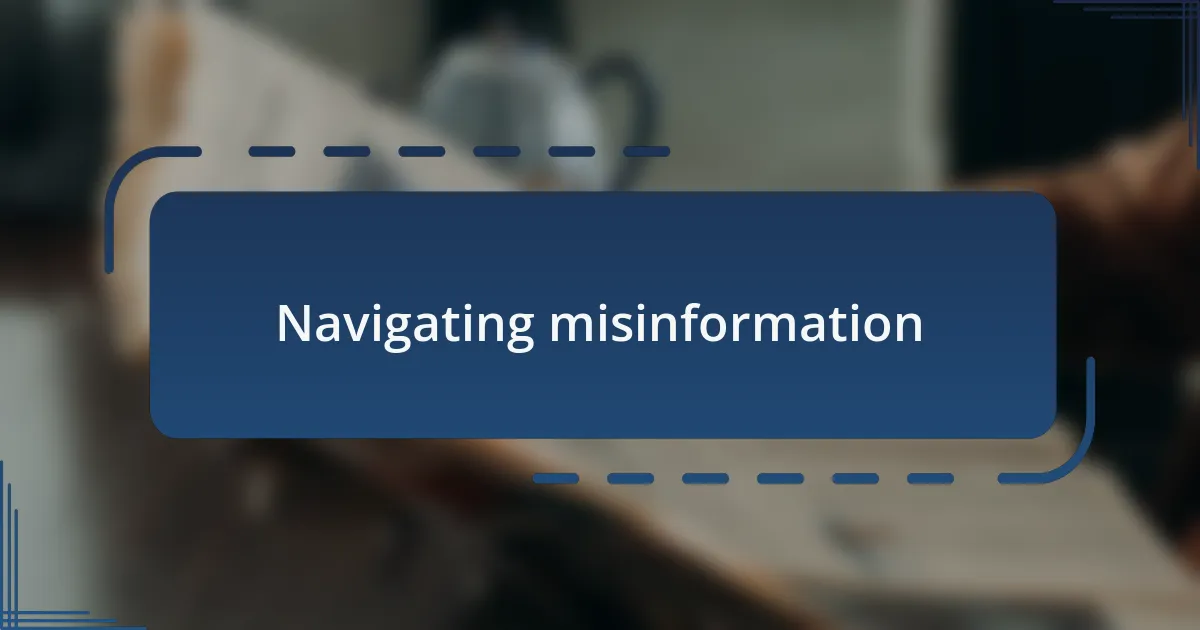
Navigating misinformation
Navigating misinformation requires a careful blend of skepticism and curiosity. I remember a time when I stumbled upon a sensational story about a public figure that seemed too outrageous to be true. The headline was eye-catching, and for a fleeting moment, I was ready to share it, driven by the thrill of shocking news. However, before I hit that share button, my instincts nudged me to pause. Isn’t it worthwhile to verify first before contributing to the chaos?
As I delved deeper into the claims, I felt a rollercoaster of emotions—excitement, doubt, and ultimately relief when I discovered that the article was misleading. This emotional journey taught me the value of critical thinking in a media landscape flooded with sensationalism. I often find myself asking: “What’s really being said here?” I’ve learned that digging beyond the surface will not only save me from embarrassment but also empower my ability to share informed opinions.
Moreover, I’ve realized that engaging in discussions about misinformation can be enlightening. I recently joined a small group of friends who exchange articles and critique their sources. It was refreshing to challenge each other’s views candidly, reinforcing that open conversations can illuminate the truth buried beneath layers of rhetoric. Have you ever felt that thrill of collective discernment? It’s a powerful reminder that we are not alone in seeking clarity amidst the noise.
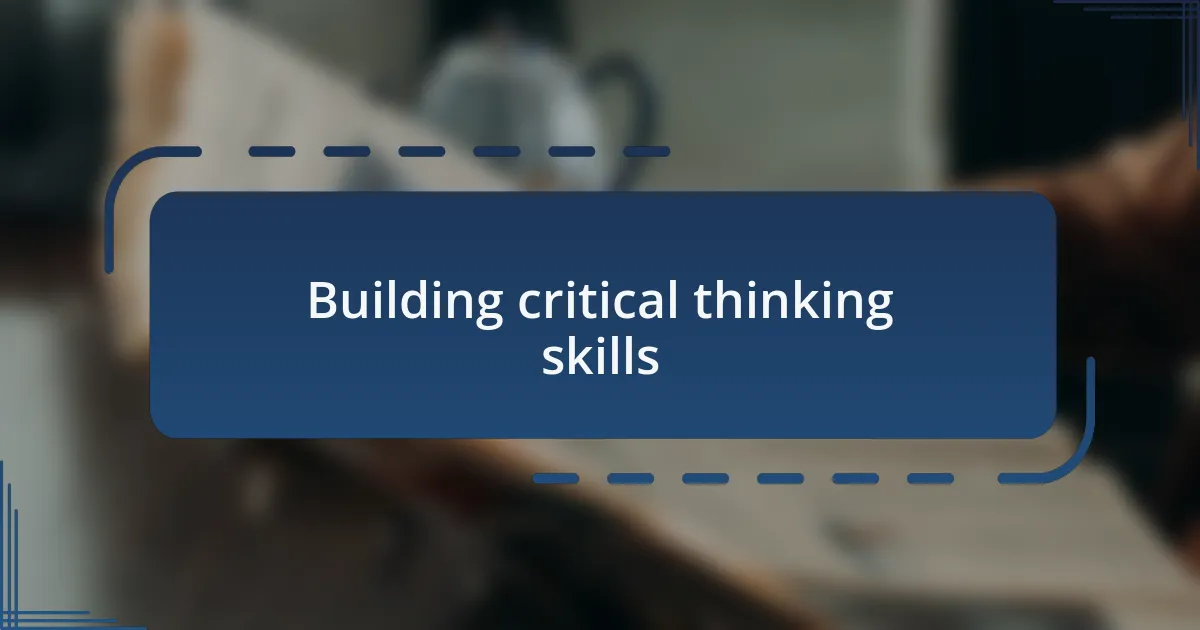
Building critical thinking skills
Building critical thinking skills is something I truly value in this era of information overload. I recall an intense debate I had with a colleague about a viral article claiming shocking statistics on crime rates. Initially, I felt compelled to defend my position based on the article, but I paused and thought: “What if the data is skewed?” That moment of self-reflection led me to dig deeper into the numbers, ultimately revealing a more nuanced picture. It’s moments like these that emphasize the importance of scrutinizing information rather than accepting it at face value.
Engaging with opposing viewpoints has also enhanced my critical thinking. Last month, I attended a webinar on media literacy, where the speaker challenged us to consider multiple perspectives on current events. This experience fueled my curiosity and led me to research further. How often do we stick to our biases without realizing it? By actively seeking out diverse opinions, I’ve learned to analyze situations more critically, identifying potential biases in my own thoughts, which has been eye-opening.
Moreover, I’ve found that practicing critical thinking isn’t just about analyzing news stories; it’s a skill that spills over into every aspect of life. Recently, during a community project, we had to strategize marketing efforts based on public feedback. Some ideas sounded fantastic initially, but I encouraged the team to question why certain responses resonated or fell flat. This collective analysis not only improved our project outcomes but reinforced the idea that critical thinking fosters collaboration and innovation. Isn’t it fascinating how questioning can lead to breakthroughs both in media consumption and real-world applications?